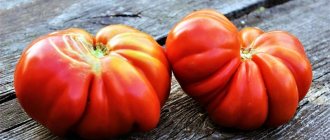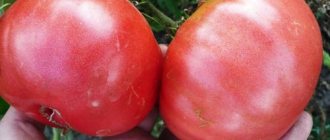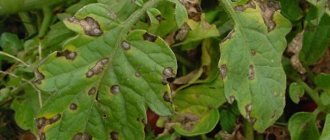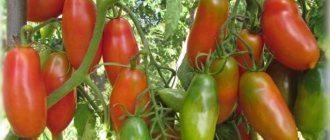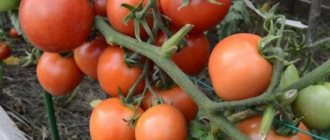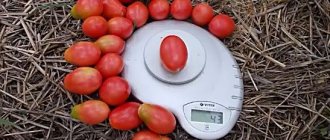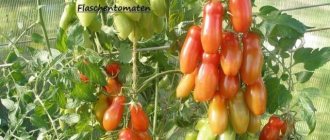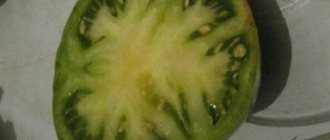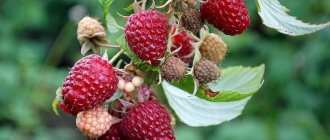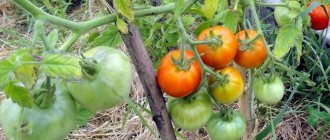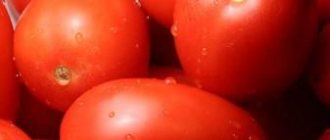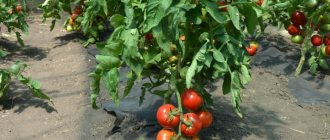Tomato Yablonka Russia variety description, photos, reviews, fruit characteristics which are presented in this article, is suitable for people who are busy with their main job and rarely visit their summer cottage. Tomato variety Yablonka Rossii does not require special care, and can develop and bear fruit in any conditions. The bushes do not need to be pinched and formed. In addition, they are very resistant to various diseases.
The productivity of this variety is high. Each bush can produce up to 100 tomatoes per season. The fruits have a pleasant presentation: small in size, round and even. They are often used for pickling and canning.
Description and characteristics of the variety
Yablonka Rossii tomatoes are not a new variety; they appeared in 1998 thanks to Russian breeders of the agrotechnical company Gardens of Russia. In 2001, this tomato variety was registered in the State Register of the Russian Federation.
- The plant is grown in all regions of Russia, except the Far North. Also, the variety is popular with gardeners in Ukraine and Moldova.
- Belongs to an early ripening variety. Ripe tomatoes begin to be picked from the bush 110 days after emergence.
- The bushes are standard, determinate. They do not need to remove the stepsons and pinch the top, since they have a specific growth point. The main stem grows up to 1m in height. Sometimes the plant can stretch up to 200-230 cm.
- There are not many shoots on the bushes and they grow closer to the main stem, without spreading to the sides. The shoots are powerful and thick, reminiscent of potato stems.
- The leaves are green and not very densely spaced.
Important! Tomatoes of this variety are intended for growing in open ground and under film.
- They do not require frequent watering and tolerate drought well.
- The plant is resistant to various infections, therefore, practically does not get sick.
- The variety has a high yield of tomatoes. Each bush produces 3-5 kg of ripe fruits.
- Harvesting begins in the first ten days of August and lasts almost until the end of September.
- Despite the fact that the Yablonka variety is suitable for growing in cold regions, gardeners from warm regions get the best results. Also, good harvests are harvested from bushes grown in greenhouse conditions.
Transplantation into open ground
10-12 days before transplanting seedlings to a permanent place, they should be hardened off. Therefore, containers with plants begin to be taken outside for 1-2 hours, gradually increasing the time the seedlings stay outside.
The time for transplanting seedlings to garden beds or greenhouses is the second ten days of May.
The area where tomato seedlings will be transplanted should be well lit by sunlight and well protected from gusts of cold wind.
Humus (6-7 kg per square area) and 500 g of wood ash are added to the beds cleared of vegetation.
The distance between the bushes of this tomato in the rows should be about 0.6 m, and the row spacing should be 0.4 m.
The seedlings, along with a lump of earth, are transferred to the prepared holes, sprinkled with earth, compacted and watered.
Related article:
How to speed up the ripening of tomatoes
Fruit characteristics
- The fruits are round in shape and small in size.
- The color of ripe tomatoes is red.
- Their skin is thick, so it does not crack.
- Tomatoes tolerate long-distance transport well.
- The average weight of the fruit is about 100 grams.
- Tomatoes have a pleasant smell and a characteristic sweet and sour tomato taste.
- Sudden changes in temperature do not change the properties of tomatoes. They remain undamaged, despite the fact that their skin is not hard at all.
- Inside the fruit there are up to 5 seed chambers, which contain many seeds. There is a thick layer of pulp between the chambers.
- The dry matter content of tomatoes is above average.
- The color of the pulp is red, and the edges are sugary.
- Ripe tomatoes can be stored in the refrigerator for a long time.
Planting care
It consists of carrying out the following agrotechnical activities:
- Watering . It should be regular, but not excessive, since the soil should not be waterlogged. It is advisable to organize drip irrigation by plunging 1 plastic bottle with holes into the ground for 2 bushes. This way the soil will always receive moisture. The gardener will only need to refill the bottles after using up the water.
- Mulching and hilling . During the period of active growth of seedlings, the ground around the bushes should be mulched with hay, sawdust or chopped weeds. Thanks to this, you can weed it much less often. Mulch will create the necessary microclimate and retain moisture in the soil, so under the influence of rising temperatures, all useful substances will flow directly to the root system of the plant. Hilling should be carried out several times a season. The procedure will stimulate the formation of additional roots, which will strengthen and strengthen the plant.
- Loosening, weeding . It is worth loosening the soil after rain, watering or applying liquid fertilizers, which will facilitate access to the flow of fresh air to the root system. In this case, you need to weed the ground so that it does not become overgrown with weeds.
- Garter . Basically, it is not required, but during the period of active growth, the bushes can, if desired, be tied to a peg using soft cloth or light rope.
- Feeding . During the entire growth period, 3-4 feedings are carried out. 2 weeks after planting, mineral fertilizer is applied - superphosphate, potassium chloride, ammonium nitrate. 2 weeks after this, the plant can be fed with one of the following:
- Infusion of mullein (bird droppings) . Dilute mullein with water in a ratio of 1:4, leave for at least 7 days, dilute with water at the rate of 0.5 liters of liquid per 10 liters of water and use for watering bushes, but in such a way that water does not get on the stems and leaves.
- Vegetable mash. Fill the container 2/3 full with dandelion, nettle, celandine or thistle, and then add mint or valerian if desired. The grass must be collected before seeds begin to form, otherwise the beds will quickly become overgrown with weeds. Next, fill the raw material with water and leave for 1-2 weeks. Dilute the finished infusion with water at the rate of 1 liter per 1.5 buckets of water and water the roots with it.
14 days after planting, seedlings should be fed with wood ash every 2 weeks.
- Protection from diseases and insects . Plant prevention consists of proper pre-sowing preparation of seeds by treatment with a solution of potassium permanganate. To prevent the development of macrosporiosis, the base of the stems should be promptly cleared of excess growth.
Photo
see what Yablonka Russia tomatoes in the photo below.
Harvest and storage
The Russian apple tree is distinguished by the simultaneous ripening of fruits, which can be picked both ripe and green, plump to the desired size. Freeing the bush from some of the fruits will stimulate the formation of new ovaries.
Green fruits are stored well and gradually reach maturity, while their taste is the same as that of tomatoes collected in a ripe state. It is better to store tomatoes in plastic boxes with drainage holes, as they are less likely to spoil and ripen quickly.
Thanks to the following video, you can make sure that the fruits collected in green form ripen and become bright red:
Advantages and disadvantages
- The main advantage of the Yablonka Rossii tomato variety is its undemandingness to growing conditions and care. At the same time, it pleases with fairly high yields.
- It can be grown not only in greenhouses, but also in open ground.
- Stable harvests.
- The fruits are of excellent quality.
- They tolerate long-distance transportation well.
Tomato is not susceptible to the main diseases: Alternaria, Fusarium, Verticillium and late blight. (Read more: Diseases and pests of tomatoes).
- An excellent variety for beginning gardeners.
The Yablonka variety, with a lot of advantages, does not have any significant disadvantages.
The only disadvantage may be susceptibility to attack by pests: aphids, thrips, spider mites.
Tomato Yablonka Russia: reviews about the variety
Tomatoes Yablonka Russia: photo of tomato variety
The tomato variety Yablonka Rossii can be confused with the Tamin variety. These are two completely different varieties. The first has large dark green foliage. Tomatoes produce 7 clusters. They have almost the same dimensions. The vegetable has 2 seed chambers, their taste is pleasant and pronounced. The pulp of the Yablonka Rossii tomato is juicy and fleshy.
I use the fruits for whole-fruit preservation. The shrubs are resistant to disease and are green in color until cold weather. The productivity of Yablonka tomatoes in Russia is high. I myself have identified a big disadvantage of the variety - it is rather poor seed germination. It happened that I planted seeds, but less than ½ germinated. It is better to buy seeding material in large quantities so that the required number of shrubs are sure to sprout.
Features of cultivation
Yablonka tomatoes are grown in the same way as other varieties, using the usual rules of care. The main thing is to buy or grow strong, high-quality seedlings yourself, plant them on time or place them in greenhouse conditions. It is also important to occasionally monitor the condition of the plant.
For the regions of central Russia and Siberia, it is better to grow tomatoes using seedlings. To do this, you need to use high-quality seeds purchased from reputable suppliers or in specialized stores. You can also collect seeds yourself from previous fruits.
Seeds for seedlings are usually planted in the first ten days of March. In order for them to be strong and germinate quickly, they must be kept for some time in a weak solution of potassium permanganate and treated with a growth stimulator - Zircon.
Well-fertilized soil is required for planting seeds. Today you can purchase a special substrate designed for growing seedlings.
In order for the bushes to more easily survive transplantation to a permanent place, it is recommended to use soil taken from the garden bed and add humus, ash, peat and superphosphate to it.
Boxes with planted seeds should be covered with film to create a greenhouse effect. Tomatoes should be kept in a warm place, but not in direct sunlight. The first shoots will appear within 3-5 days. At this point, the film can be removed and the seedlings placed in a bright place, for example, on a windowsill.
Tomatoes develop well in daylight for at least 10 hours a day. If there is not enough sunlight in the region, they need additional lighting.
After the first two leaves appear, the plants dive. In this case, the root system will strengthen and will grow both in length and width. This will allow the bushes to easily take root in a new place.
10-14 days before planting, seedlings should undergo a hardening procedure. First, the trays with seedlings are taken out onto the balcony or into the yard for several hours, provided the weather is good. Every day, the time the plants spend in the air is increased, and then they are left in the air overnight if the temperature does not drop below +5 degrees.
Seedlings of the Yablonka Rossii variety are transferred to open ground 2 months after sowing the seeds. At this time, the bushes already have 6-8 strong leaves, and flower clusters may even appear.
Important! Tomatoes of early ripening varieties are usually planted in a permanent place in mid-May. However, the climatic conditions of the region should be taken into account. If there is a threat of night frosts, then it is better to hold off on transplanting seedlings.
Experienced gardeners do not advise planting tomatoes in an area where crops such as potatoes, tomatoes, eggplants and physalis grew last season. The fact is that after these vegetables the soil can be infected with late blight pathogens.
It is better to plant tomatoes in places where legumes and vegetables grew in the past: carrots, beets, pumpkin, onions.
Before you start planting seedlings, you need to dig holes for them. The distance between the bushes should be from 50 to 70 cm. When the plantings become denser, the fruits will be small, the yields will decrease, and the taste of the tomato will deteriorate.
In addition, after transferring the seedlings to open ground, they must be covered with film. It is especially important to do this procedure in areas with cold climates. The film is not removed immediately, but gradually.
More information about growing tomatoes is described in the article: Technology of growing tomatoes. Secrets of planting and care
You might be interested in: How to properly plant tomatoes in a greenhouse: bush formation diagram, care features, photos and videos
Useful information: How to properly tie tomatoes in open ground: the best methods, step-by-step photo and video instructions
Planting seedlings
The Yablonka tomato in Russia should be grown only through seedlings. Moreover, if the seedlings grown at home are healthy and strong, then this will be the key to a future high harvest.
Tomato seedlings
Seed material should be planted in the second ten days of March, so that after 55-60 days the grown seedlings can be transplanted to a permanent place.
Nutrient substrate is usually purchased at a gardening store, but many vegetable growers prefer to prepare a nutritious soil mixture themselves. To do this, they have been stocking the following components since the fall:
- turf;
- high peat;
- humus or compost;
- river sand.
These ingredients are mixed in a ratio of 1:2:1:0.5. You should also add 1 tbsp to this mixture. l. superphosphate, st. l. potassium salt, 10 g urea.
To make the soil mixture looser, it is recommended to add vermiculite or sawdust.
Approximately 10-12 days before planting the seed, the soil mixture prepared at home must be disinfected. To do this, you can pour it with a weak solution of potassium permanganate or keep the substrate in an oven preheated to 180 degrees for 15-20 minutes.
Related article:
The earliest varieties of tomatoes: types and descriptions
Then the soil mixture needs to be spread out into containers, watered and seed material spread over its surface. It is covered with a 1 cm thick substrate on top, covered with polyethylene and placed in a warm room, the temperature in which should be about 25 degrees Celsius.
After the sprouts appear, it is necessary to remove the polyethylene and move the containers to a bright place, preferably on a windowsill facing south.
Growing seedlings are periodically watered (as the top layer of the substrate dries) with warm, settled water. After the plants have several permanent leaves, they should be picked into separate containers.
This is interesting: How to pick tomatoes correctly and when
During the growing period, seedlings are fed a couple of times with liquid fertilizer intended for vegetable plants.
Related article:
How to protect tomato leaves from wilting
Diseases and pests
The shoots of the Russian apple tree are little affected by fungi; the friendly yield of the harvest allows one to obtain ripe fruits before the massive development of nightshade diseases.
Useful properties and the most delicious recipes for carrot tea
In rainy years, the variety may become susceptible to late blight early. For prevention, a one-time spraying with 1% Bordeaux mixture or other copper-containing fungicide is sufficient.
The tender tops of the plant are often attacked by aphids, thrips, and spider mites. Small lesions are fought with folk remedies with a deterrent effect: ash-soap solution, infusions of garlic, onion peels, celandine. In advanced cases, contact insecticides are used.
Important! Chemicals can be used at least 3 weeks before tomatoes ripen. The exception is the biological product “Fitoverm”, which completely decomposes in the environment in 3-5 days.
